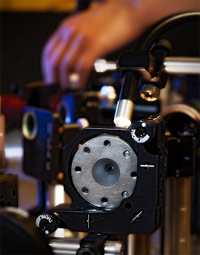Metallic glass: a crystal at heart
25 Jun 2011
Glass, by definition, is amorphous; its atoms lack order and are arranged every which way. But when scientists squeezed tiny samples of a metallic glass under high pressure, they got a surprise: The atoms lined up in a regular pattern to form a single crystal.
 |
| Scientists used a diamond anvil cell like this one to squeeze tiny samples of metallic glass. Under very high pressure, the samples switched from their amorphous, glassy state to form a single crystal-the first time this behavior has been seen in a glass. (Image by Brad Plummer/SLAC.) |
It's the first time researchers have glimpsed this hidden property in a glass. The discovery, reported June 17th in Science, offers a new window into the atomic structure and behavior of metallic glasses, which have been used for decades in products such as anti-theft tags and power transformers but are still poorly understood. The more scientists learn about the structure of these commercially important materials, the more effectively they can design new metallic glasses and tinker with old ones to improve their performance.
''Maybe a lot of glasses have this underlying structure, but we just didn't know how to look for it,'' said paper co-author Wendy Mao, a mineral physicist at the Department of Energy's (DOE) SLAC National Accelerator Laboratory and Stanford University.
Daniel Miracle, a metallurgist at the Air Force Research Laboratory in Ohio who was not involved in the research, called the discovery ''a really, really neat, important finding.'' Not only will it help researchers design better metallic glasses, he said, but it may help explain why these materials can be so tough: If each piece of glass is a single crystal at heart, it doesn't have any of the weak spots at the boundaries between crystals where fractures and corrosion tend to start.
Unlike familiar window glass, metallic glasses are alloys made of metals-in this case cerium and aluminum. They resist wear and corrosion and they have useful magnetic properties. If you took apart the plastic anti-theft tag on a DVD case, you'd find a thin piece of metallic glass that looks like aluminum foil. When you rent or buy a DVD, the checkout clerk rubs it across a pad to demagnetize the metallic glass so it won't trigger an alarm when you leave.
Scientists have been investigating metallic glasses for half a century, and in 1982 turned up the surprising discovery that these glasses do have some atomic structure, forming patterns over distances spanning just a few atoms. But no long-range patterns were apparent.













.jpg)






.jpg)









